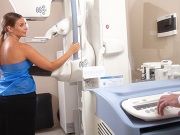Article
Bundled Payments May Reduce Cancer Costs
Author(s):
Expanded use of bundled payments in cancer for services such as mammography.

New research suggests that mammography may present an opportunity for the expanded use of bundled payments in radiology.
Investigators from Neiman Institute developed a bundled payment model for mammography, and calibrated it by using data from a private health system, as well as Medicare claims data. To develop the bundles, researchers used a screening mammography event, in addition to an array of downstream diagnostic breast imaging services during a 364-day episode window.
According to a study published in the Journal of the American College of Radiology (JACR), breast cancer screening provides a framework for radiologist-led bundled payment models and can be implemented with difference services included in the bundle that depends on a practice’s specific patient panel.
“In an effort to curb health care costs and improve the quality of care, bundled payment models are becoming increasingly adopted,” said senior research fellow Danny R. Hughes, PhD. “To date, these models have focused primarily on treatment episodes and primary care providers. To achieve current Medicare goals of transitioning fee-for-service (FFS) payments to alternative payment models, a broader range of patient episodes and specialty physicians will need opportunities to participate.”
Researchers were able to find considerable variation among imaging care pathways, however, they found that breast cancer screening had the benefit of well-established practice parameters and structured reporting that could reduce the variation, according to the study.
“As the US health care delivery system transitions from FFS to value based payments, it’s important that we [radiologists] are at the table to ensure that our patients have access to high quality imaging,” said Geraldine McGinty, MD, MBA, FACR, vice chair of the American College of Radiology (ACR) Board of Chancellors and member of Neiman Institute’s advisory board. “Shaping payment policy to support that access is at the core of ACR’s mission. Bundled payments are seen by policymakers as a vehicle for aligning incentives and in fact the Centers for Medicare and Medicaid Services (CMS) have now imposed mandatory bundling for joint replacement and cardiovascular care.”
Although the report does not provide a proposed price that CMS or other payers should pay for a breast cancer screening episode, it does layout the framework from which an individual practice may build a model with a payer, based on their own individual population and practice, the study authors noted.
“Aside from serving as a model to demonstrate how diagnostic radiologists can participate in bundled payment models, this research initiative has the potential to fundamentally change the way mammography is paid for in this country,” Hughes said. “Because screening bundles include costs for follow-up diagnostic imaging in addition to the initial screening mammogram, patient adherence to screening guidelines may improve — which may have profound effects on public health in a way that’s great for patient, providers, and payers.”






